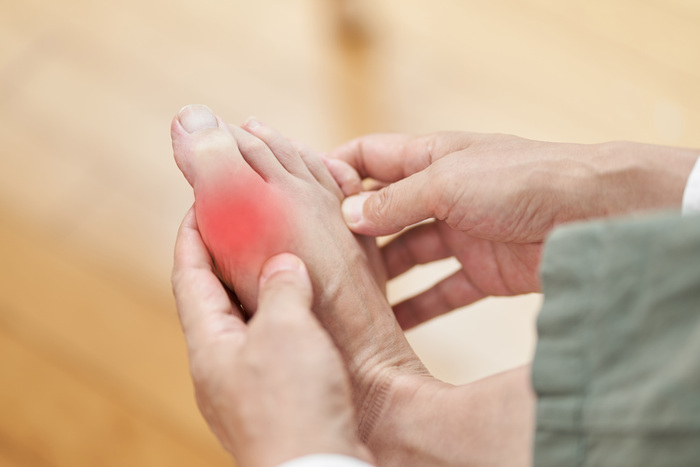
Ensure your health. Get tested today.
Convenient lab testing at your fingertips at more than 5,000 locations nationally. Consult with a doctor, or get tested on your own.

Gout is a complex form of arthritis that can affect anyone, according to the Arthritis Foundation. They explain that it is characterized by sudden and severe episodes of pain, tenderness, redness, and swelling in the joints. Gout typically presents with acute, intense pain in the affected joint, often starting at night. The big toe is the most commonly affected area, but gout can also occur in other joints such as the ankles, knees, elbows, wrists, and fingers, according to the Arthritis Foundation. They note that the pain is usually most severe within the first 12 to 24 hours of the onset and can be accompanied by swelling, warmth, and redness of the joint. In some cases, the skin around the joint may appear shiny and feel tight.
Other symptoms of gout can include lingering discomfort after the severe pain subsides, which can last from a few days to a few weeks, according to the Arthritis Foundation. Recurrent attacks may become more frequent and severe over time, potentially leading to chronic gout and joint damage. Additionally, the presence of tophi—lumps of urate crystals that form under the skin—can be a sign of advanced gout, according to the Arthritis Foundation. Recognizing these symptoms early and seeking medical advice is crucial for managing the condition and preventing long-term complications.
Accurate diagnosis of gout is essential for effective treatment and management of the condition, according to the Kidney Foundation. They note that various tests can help healthcare professionals confirm the presence of gout and differentiate it from other forms of arthritis. These diagnostic tools not only aid in identifying the disease but also in assessing its severity and monitoring the effectiveness of treatment.
Below are some of the key tests used to diagnose gout, according to the Kidney Foundation:
Joint Fluid Test: This is considered the gold standard for diagnosing gout. A healthcare provider will use a needle to draw fluid from the affected joint. The fluid is then examined under a microscope to detect the presence of urate crystals, which are indicative of gout.
Blood Test: Blood tests can measure the levels of uric acid in the bloodstream. Elevated uric acid levels can suggest gout, although not everyone with high uric acid will develop the condition. Conversely, some people with gout may have normal uric acid levels during an attack.
X-ray Imaging: X-rays can help rule out other causes of joint inflammation, such as fractures or other types of arthritis. While X-rays are not typically used to diagnose gout in its early stages, they can be useful in identifying joint damage caused by chronic gout.
Ultrasound: This imaging technique uses sound waves to create images of the joints and can detect urate crystals in the joint or in tophi. Ultrasound is increasingly being used due to its ability to identify gout-related changes that are not visible on X-rays.
Dual-Energy Computerized Tomography (DECT): DECT is a specialized imaging test that can detect urate crystals in the joints and soft tissues with high accuracy. This advanced technique can be particularly helpful in diagnosing gout when other tests are inconclusive.
These tests collectively provide a comprehensive approach to diagnosing gout, enabling healthcare providers to tailor treatment plans effectively and improve patient outcomes, according to the Arthritis Foundation.
Treating gout effectively involves both managing acute attacks and preventing future flare-ups, according to the CDC. They note that a combination of medications and lifestyle changes can help control the symptoms and reduce the risk of complications.
When a gout attack occurs, prompt treatment is essential to alleviate pain and inflammation — below are some of the primary medications used to treat gout attacks, according to the CDC:
Nonsteroidal Anti-Inflammatory Drugs (NSAIDs): NSAIDs such as ibuprofen, naproxen, and indomethacin are commonly prescribed to relieve pain and reduce inflammation during a gout attack. These medications are typically taken at higher doses initially and then tapered down as symptoms improve.
Colchicine: Colchicine is another effective medication for treating gout attacks, especially if taken soon after symptoms begin. It works by reducing the inflammatory response to urate crystals in the joints. However, it can cause side effects such as gastrointestinal upset, so it is usually prescribed in low doses.
Corticosteroids: Corticosteroids like prednisone can be prescribed for patients who cannot tolerate NSAIDs or colchicine. These powerful anti-inflammatory drugs can be taken orally or injected directly into the affected joint to provide rapid relief from pain and swelling.
These medications are essential tools in managing gout attacks, but long-term treatment strategies may also include medications to lower uric acid levels and lifestyle modifications to prevent future episodes, according to the CDC.
In addition to medical treatments, lifestyle changes, and home remedies play a crucial role in managing gout and preventing future attacks, according to the Arthritis Foundation. Adopting healthy habits can help reduce uric acid levels, alleviate symptoms, and improve overall well-being.
Below are some effective lifestyle and home remedies to consider for treating gout, according to the Arthritis Foundation:
Exercise and Eat a Balanced Diet to Control Your Weight: Maintaining a healthy weight through regular exercise and a balanced diet can help reduce the risk of gout attacks. Obesity is a risk factor for gout, so weight management is essential.
Drinking Lots of Water: Staying well-hydrated helps dilute uric acid levels in the blood and may prevent the formation of uric acid stones. Aim to drink plenty of water throughout the day.
Stay Away from Sugary Drinks: Sugary beverages, especially those sweetened with high-fructose corn syrup, can increase uric acid levels and trigger gout attacks. Opt for water or other non-sugary drinks instead.
Avoid Alcohol: Alcohol, particularly beer and spirits, can raise uric acid levels and trigger gout attacks. Limiting or avoiding alcohol can help manage the condition more effectively.
Eat Less Meat and Seafood: Reducing the intake of purine-rich foods such as red meat, organ meats, and certain types of seafood can help lower uric acid levels. Instead, opt for protein sources like low-fat dairy products, which have been shown to have a protective effect against gout.
Take Medicines to Lower Uric Acid Levels: In addition to lifestyle changes, taking prescribed medications to lower uric acid levels can help prevent gout attacks and complications. These medications should be taken as directed by your healthcare provider.
Implementing these lifestyle and home remedies can significantly contribute to managing gout and improving your quality of life, according to the Arthritis Foundation. Combining these strategies with medical treatments can offer a comprehensive approach to controlling this condition.
Gout is a form of arthritis that causes sudden, severe attacks of pain, redness, and swelling in joints. The big toe is often affected, but it can occur in other joints as well.
Gout is diagnosed through several tests including a joint fluid test, blood test, X-ray, ultrasound, and Dual-Energy Computerized Tomography (DECT).
Treatment options for gout include medications like NSAIDs, colchicine, and corticosteroids, as well as lifestyle changes and home remedies to manage symptoms and prevent future attacks.
Lifestyle changes that can help manage gout include maintaining a healthy weight, staying hydrated, avoiding sugary drinks and alcohol, reducing intake of purine-rich foods, and taking prescribed medications to lower uric acid levels.
Untreated gout can lead to more frequent and severe attacks, chronic gout, joint damage, and the formation of urate crystals under the skin.
Yes, home remedies like regular exercise, staying hydrated, avoiding sugary drinks and alcohol, eating less meat and seafood, and taking prescribed medications to lower uric acid levels can help manage gout.
Yes, if gout is not properly managed, recurrent attacks may become more frequent and severe over time, potentially leading to chronic gout.
While gout itself is not curable, its symptoms can be managed and future attacks can be prevented through a combination of medications and lifestyle changes.

Convenient lab testing at your fingertips at more than 5,000 locations nationally. Consult with a doctor, or get tested on your own.